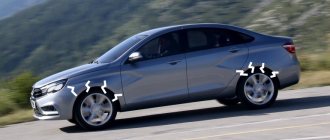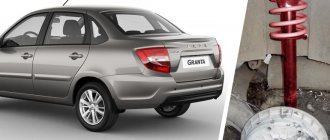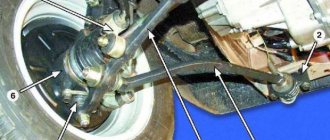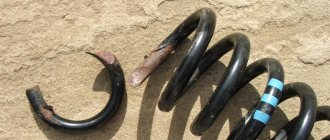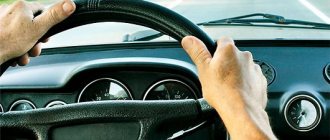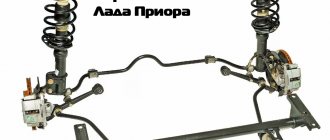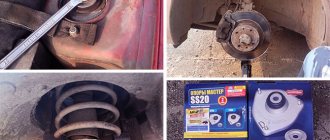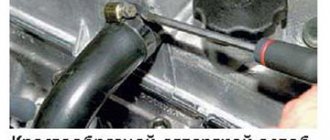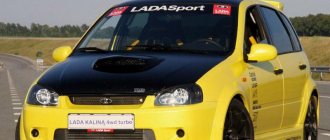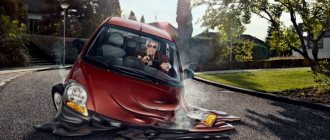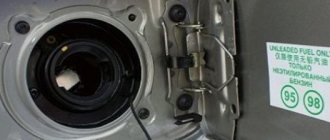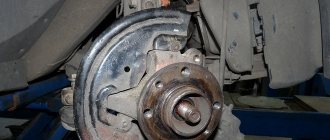When driving onto areas with uneven roads, drivers may hear a slight knocking sound in the front suspension on small bumps. This symptom can make a large number of young car owners nervous.
The point here is not only the fear that some part may fall off while driving, but rather car enthusiasts are worried about possible future repairs. The cost of work to restore the suspension can cost about 500-1000 dollars. Therefore, you can carry out diagnostic work yourself, and later, having discovered a problem, you can also fix it yourself.
Problematic suspension
Possible causes of knocking in the front suspension lie in its levers. Complete with poor handling, silent blocks are often possible culprits. A mount is suitable for diagnosing them. It is used as an elongated shoulder. By bending the levers in different directions, significant play may appear.
If the structure is collapsible, then the silent blocks will need to be replaced. This is done after dismantling the lever and pressing the silent block out of the hole. The operation will require a special device. Before installing new silent blocks, they must be lubricated to reduce friction. It is also necessary to clean the seating surface from dirt.
Why does a knock occur in the suspension?
This is what the assembled Kalina front suspension looks like
Poor road surface condition and low-quality spare parts can be one of the reasons for knocking in the suspension. Another important problem is wear. This reason occurs quite often, especially when the car owner does not carry out maintenance or diagnostics of the suspension in a timely manner.
Causes and treatments
In the table we will look at what specific reasons can cause a knock in the suspension, as well as how to eliminate these breakdowns.
| Cause | Elimination method |
| Rack failure | Replace or repair the rack |
| The stabilizer bar is weakened or damaged. Rubber cushions or stabilizer bars are worn out. The tightening bolts are loose | Tighten the bolts. Replace worn parts |
| The rack fastenings are loose in the upper part, where it is attached to the body | Tighten the top fastening nut |
| Wear of the rubber element of the strut | Replace the rubber element |
| Wear of silent blocks of the lever, stabilizer or braces | Replace a set of silent blocks |
| Wear of ball joints | Replace ball joints |
| Suspension spring failure | Spring replacement |
| Wear of the compression stroke buffer | Replace buffer |
| Large wheel imbalance | Balance the wheels |
Steering problems
Experienced drivers can tell you that knocking in the front suspension on bumps does not only occur in obvious problem areas. Shock absorber struts are often blamed for this, but the problem turns out to be not in them or even in the support bearing, which young car owners are guilty of.
The reason may lie in the steering. By checking this unit, which often produces a sound similar to the knocking of shock absorbers, you can detect problems with the rack. Noises from it are usually heard on one side. An additional sign indicating this element is a slight vibration of the steering wheel. It can be felt while driving on a gravel road.
The sound comes from the interaction of the rack and the gear moving along it. The gap can gradually increase, and the intensity increases from this. This appears as a result of significant wear on the mating surfaces of the pair. You can jack up one of the front sides of the car and shake the steering rods in different directions.
At this time, you need to observe their behavior. If play is felt, then the supposed dull knock in the front suspension felt by the driver may arise from worn bushings.
With a possible rotation of the rack, one can argue about a gap in the pair. However, it can be easily eliminated by tightening the rack to the gear. Bushings in which developments have formed are also considered repairable products. Their repair kit is easy to purchase at a car store.
The culprit for strange noises may be the steering joint. When diagnosing it, you need to seek help from a partner, who will sharply rotate the steering wheel at small angles during the inspection process.
At this time, the car owner must fix the body, hinge and pin. Unnecessary play will be heard immediately. Replacing this unit will cost much less than a complete suspension repair.
conclusions
As can be seen from the article, it is quite easy to find the reason for the knocking of the Lada Kalina’s suspension on small bumps. If you pay attention to the table, you can see that all possible options and methods for eliminating them are listed. It is also worth noting that it is necessary to regularly carry out maintenance and diagnostics of the car, and then the likelihood of this effect occurring is reduced.
The cause of knocking in a car's suspension is most often the shock absorber struts. At the same time, such a knock is characterized by the fact that it appears only on the side where the strut is faulty - this is why you can usually hear the knocking clearly either in the front suspension, or in the rear, or in the front, or in the rear.
Most often, knocking in the suspension appears only on bumps. In this case, the culprits for such a knock may be:
- worn or damaged racks, as mentioned above;
- worn or damaged leaf springs, brackets holding them together;
- worn or damaged control levers (in this case, knocking in the suspension may occur on bumps only when turning the steering wheel and only from the front);
- damaged or damaged ball joints;
- broken shock absorbers also often cause knocking;
- weakened or damaged body supports - knocking also occurs only in the front suspension.
When it comes to diagnosing a knocking noise when driving over bumps, the most obvious thing required is a road test to determine the source and nature of the sound. Before you take your car on a road test, you need to walk around the car to make sure nothing falls off while driving. Look carefully under the bottom of the car.
A quiet thud in the suspension due to the struts
Press down on the front and rear of the car. This will determine if the racks are working properly. If the racks are working correctly, the car body will rise after you stop putting pressure on the car and return the body to its original state.
Step two - start the engine. Turn the wheels from lock to lock in both directions alternately. This will determine whether the skid plates make a clicking noise or a rhythmic noise when the vehicle is stationary.
Inspect the racks themselves for fluid on them - if one of the racks is leaking, it needs to be replaced. In some cases, to inspect the racks, you will need to jack up the car and remove the wheels.
Typically, failed struts are characterized not only by a dull knock, but also by discomfort when driving - you may feel that the car has begun to handle road unevenness differently, hitting the “fifth point” hard even in small holes or bumps.
If after checking you find out that the struts are in working order, and the reason for the knocking is not in the suspension, do not rush to draw conclusions. Open the hood and locate the mounting studs and nuts with the strut support plate. Check to see if these bolts or nuts are loose - sometimes they can be the cause of a knocking sound in the suspension.
Loud thud due to damaged springs
Leaf spring clamps tend to wear out on vehicles over time, even under normal road and operating conditions. In this case, they can knock. Typically, the clamp on one end of the leaf spring will become deformed or broken, creating a characteristic loud thud.
To check the cause of knocking in the springs, first, visually inspect them for visible damage. In the case of broken clamps, you can easily find them.
You can then perform the following diagnostic procedure. Get behind the wheel and start driving slowly. Then press the brakes sharply and firmly, and then accelerate sharply and strongly. If the cause of the knocking is in the springs, then in this case it will manifest itself especially strongly. A loose leaf spring clamp may not make noise when operating normally, but may move, making a thumping noise when the center of mass is suddenly shifted by hard braking and acceleration.
In any case, check the fastening of the bolts and nuts of the clamp holding the spring leaves together.
Typically, problems with springs should be corrected as soon as possible, and driving such a car is highly undesirable.
Knock in the suspension not only when driving, but also when turning the steering wheel - ball joints
Ball joints tend to wear out in cars over time under normal driving conditions. In the case where the cause of the knocking in the suspension is the ball joints, the knocking is typical only for the front suspension.
Take a flashlight and visually inspect the ball joints and suspension of the vehicle. Raise one side of the front of the car on a jack and try to shake the lifted wheel - if it has play, then the cause is most likely the ball joint. In addition, you may also feel such play on the steering wheel.
Try turning the steering wheel from lock to lock in both directions - if the ball joints are worn out, the knock will appear not only when driving, but also when the car is stationary.
Rack support
The upper part of the support causes a dull knock in the front suspension on bumps. The rubber base serves as a damper against possible excess noise. But flexibility may be lost, and once the base is capable of recurrent deformation, it becomes “woody” and begins to wear out.
Because of the sounds that appear, drivers can completely overhaul the suspension , spend a lot of money and time, but still not get rid of the cause of the noise. This problem can be identified by measuring the gaps between the support itself and the plastic limiter. Depending on the design, vehicles may have closed access for this unit. In the rest, the approximate average parameter should be about 10 mm.
This node can be assigned as the culprit only if clear noise is detected on one side. It is unlikely that uniform output will appear on both sides at the same time.
Posts 1 to 25 of 63
1 Topic by anatolii 01/31/2015 18:01:39
- anatolii
- Participant
- Inactive
- From: Degtyarsk (Ekaterinburg)
- Messages: 38
- Thank you: 2
Topic: Knock in supports
I have one when there is more of a hole, there is a metallic knock, as they say, “the stand is falling”? On a speed bump too, if you drive a little faster, the wheel falls off with such a blow. How do you fight this?
2 Reply from .gsm 01/31/2015 18:25:33
- .gsm
- New member
- Inactive
- Messages: 2
- Thank you: 0
Re: Knock in supports
My mileage is 1000 km, on bumps the rear strut seems to be knocking, I'm waiting for 2000 km
3 Reply from anatolii 01/31/2015 18:29:43
- anatolii
- Participant
- Inactive
- From: Degtyarsk (Ekaterinburg)
- Messages: 38
- Thank you: 2
Re: Knock in supports
My mileage is 1000 km, on bumps the rear strut seems to be knocking, I'm waiting for 2000 km
4 Reply from 7TT 01/31/2015 18:55:02
- 7TT
- Participant
- Inactive
- From: Orenburg
- Messages: 690
- Thank you: 58
Re: Knock in supports
My mileage is 1000 km, on bumps the rear strut seems to be knocking, I'm waiting for 2000 km
Check the top nut first.
5 Reply from max-xx 01/31/2015 20:04:45
- max-xx
- Moderator
- Inactive
- From: Moscow
- Messages: 2,886
- Thank you: 375
Re: Knock in supports
Pull the pendant to start. I didn’t notice anything metallic in the above situations. Yes, the suspension worked. but without unnecessary overtones. Mileage 7.5 t.km.
6 Reply from Vadyai 01/31/2015 23:26:22
- Vadyai
- Participant
- Inactive
- From: Ulyanovsk
- Messages: 77
- Thank you: 4
Re: Knock in supports
I have one when there is more of a hole, there is a metallic knock, as they say, “the stand is falling”? On a speed bump too, if you drive a little faster, the wheel falls off with such a blow. How do you fight this?
This is normal, the struts “hit” in the return way - you need to drive more carefully.
7 Reply from 7TT 01/31/2015 23:46:33
- 7TT
- Participant
- Inactive
- From: Orenburg
- Messages: 690
- Thank you: 58
Support bearing problem
This sound is similar to the production of a damper, but is louder. To detect damage, it is advisable to remove the stand. There are specifics to the failure of this bearing. His output is always unequal along the entire perimeter. Its greatest degree will be at the moment when the movement of the car is smooth, without turns.
This knocking noise may disappear when moving to the right or left. If this happens, this algorithm is found. Additionally, the check can be carried out with the help of a partner. He will have to swing the car vertically. The car owner will hold onto the shock absorber struts underneath his vehicle. You can feel the vibration with your hand.
Ball joints
Experienced drivers often call this suspension element the source of the “classic” knock in the front of the car. However, this “disease” has its own specifics and affects rear-wheel drive cars to a greater extent. Therefore, motorists who do not change their VAZ rush to “change the ball joints.”
The bearing on the hinge causes vibration when driving on uneven roads.
The check begins by hanging the wheel on the problem side. Next, without rotating the disk, we try to turn it sharply to the right/left several times. To eliminate the influence of the bearing from the hub, a partner can depress the brake pedal during the test.
Problem stand
Experience has shown that the strut can also produce sounds when driving on gravel. Although this happens quite rarely, it is also possible to check this node. A rack that has been subjected to significant wear but is still filled is capable of transmitting shocks.
This happens noticeably when you hit a hole while driving , but it does not respond to the rebound, and the spring sharply straightens. It turns out the wheel goes down sharply. By stretching to its maximum length and then making contact with the opposite part of the pit, two strokes will form.
You can check the performance of the rack in the standard way by vertically rocking the car and pressing sharply on the hood with force. The body of the car must once gently return to its original position. Such actions indicate the health of the node.
In very rare cases, a loose lock nut can make noise inside the rack.
But then the car will sway while driving and lose control. The noises will not resemble regular knocking, but will arise spontaneously. Mandatory renovation required.
Failure of shock absorbers usually occurs due to negligence. Oil of a certain viscosity is poured inside them. This indicator is also affected by the ambient temperature. Too low does not increase the fluidity of this liquid.
An inexperienced driver who has slightly warmed up the engine oil may start the car abruptly without sparing the suspension. Due to such a maximum viscous force, small and fragile elements of the rack structure can be damaged. It is also possible to have oil with high viscosity in sports cars. At the same time, the suspension is tightened.
Which shock absorbers are better for the Lada Kalina?
Shock absorbers for Kalina VAZ 1117, 1118, 1119 are practically no different from each other, except for the size of the cup for the shock absorber spring in the VAZ 1119 model. For the conveyor, these chassis spare parts are produced at the SAAZ plant.
Front shock absorbers for Kalina 1117, 1118, 1119
According to their technical parameters, front shock absorbers for Kalina are divided into right-hand and left-hand, and for VAZ 1119 models the cup width will be smaller than for VAZ 1117 and 1118. Shock absorbers with the article number right. 11182905002 / lion 11182905003 were installed on the VAZ 1117 and 1118 of the first modifications. And the details with art. number 11192905002 (right), 11192905003 (left) were installed on VAZ 1119 of all model series and VAZ 1117 and 1118 latest versions. Front shock absorbers 1118 and 1119 are interchangeable with each other, but the difference is in the springs.
On cars with an eight-valve engine (the exception is the VAZ 1117 station wagon), conical springs art. 11182902712 or shaped barrel springs art. 11192902712. For cars with a 16-valve engine and for the VAZ 1117, springs with higher stiffness and load rating are installed - article numbers 111862902712 and 111962902712.
The shock absorber parameters are shown in the table:
| Dimensions of front shock absorbers for Lada Kalina 1117, 1118, 1119 | |||
| 22 | 52 | 177 | 360 |
Analogs of front shock absorbers Lada Kalina 1117, 1118, 1119
Original shock absorbers are in demand when replacing front struts, but increasingly, spare parts from other manufacturers are being supplied to the Russian market, which are not inferior, and in some cases, superior to original products. A list of the most popular shock absorbers is presented in the table.
| Front shock absorbers for Lada Kalina (1117, 1118) first modifications | ||
| At program | Right AT5002118SA Left AT5003118SA | 5000 (set, 2 pcs.) |
At program Right AT5002118SAG Left AT5003118SAG 1800
Pilenga Right SHP2718O Left SHP2728O 2200
Front shock absorber struts for VAZ 1119 (entire model range) and 1117, 1118 later modifications
Kroner Right K350319 Left K350419 5000 (set, 2 pcs.)
QML Right SA1011 Left SA1010 1500
QML Right SA1013 Left SA1012 1500
Shock absorber VAZ 1118
Shock absorber Pilenga SHP2718O(right)
The catalog number of the rear shock absorber for all Kalina models is 11182915004. In terms of technical properties, there will be practically no differences between the front and rear struts. In addition, this shock absorber is the same for both the right and left sides. Technical dimensions are presented in the table below.
| Dimensions of rear shock absorbers for Lada Kalina 1117, 1118, 1119 | |||
| 14 | 30 | 229 | 364,5 |
Analogs of rear shock absorbers Lada Kalina 1117, 1118, 1119
Many drivers use original domestic or imported spare parts to replace rear struts. As a rule, preference is given to SS-20 or Kayabe companies. Below is a list of spare parts from other popular companies among car enthusiasts.
| Rear shock absorbers for Lada "Kalina" 1117, 1118, 1119 | ||
| Finwhale | 120812 | 1400 |
| Finwhale | 120822 | 1400 |
| Hola | S432 | 1200 |
Shock absorber Finwhale 120812
Shock absorber Hola S432
Which shock absorbers are better for the Lada Kalina? As practice shows, they prefer to install Kayaba or SS-20, they have a good balance between rigidity and comfort, and are also distinguished by enviable reliability. For a softer ride, choose racks made by Acomi.
When to change shock absorbers on Lada Kalina?
Replacing shock absorbers on a Kalina depends on the wear of the spare part, which in turn is largely determined by the operating conditions of the vehicle, such as; road surface, driving style and weather conditions in a particular area. The average service life of original struts is 60-100 thousand km; however, there are cases when the shock absorber leaks much earlier than 35 thousand km, so drivers try to immediately replace them with imported analogues.
Even more useful tips in a convenient format
Subscribe
Did not find an answer to your question?
Possible rare causes of knocking
The stabilizer bar bracket is checked for integrity or noise. Its design contains bushings with rubber elements. They are connected by a rather fragile beam. Sometimes it bursts and makes a knocking sound when the car rocks. You can shake it by hand on the wheels turned to the side.
It happens that the supports on which the engine is mounted burst. While driving, the unfixed motor under the hood moves. With its protruding parts, it can knock on the car body. This knocking noise is often confused with the sounds of a problem suspension.
A variety of noises can occur under the hood of a used car. The cause is even elements that are simply not tightened to the required level. It is not always worth rushing to the station to identify problems. Most of these causes can be identified and eliminated on your own.
A knock in the front suspension usually appears suddenly and can alarm anyone, even the most experienced driver. This problem almost never occurs in new cars, but the older the “iron horse”, the greater the likelihood of such troubles occurring. This review is about the most common sources of sound in the suspension.
The first place to start inspecting a car is with the levers. As soon as some defect occurs in the latter, the suspension begins to knock. Among the most common defects is wear of rubber-metal hinges (silent blocks). If the steering wheel begins to oscillate while driving, this can lead to deterioration in the car’s controllability, and at high speeds such a problem can even lead to a run off the road, so there is no point in wasting time checking and repairing it. In order to identify the wear of the rubber-metal hinges, you just need to shake the ends of the rods with a mounting tool. The problem in silent blocks can be eliminated by replacing them.
When checking the car, attention should also be paid to the tie rod ends. A knock may occur due to large play in the finger in the socket. Play in this area can be detected in another way, simply by shaking the steering wheel from side to side.
A knock in the front suspension can also occur due to ball joints that may have worn out a long time ago. You can get rid of such a knock only by completely replacing the worn part. The main task assigned to the ball joints is to turn the steered wheels. This part takes on the maximum load that appears on a poor-quality road surface. You cannot delay replacing ball joints - the longer you delay, the greater the likelihood that they will tear out and the vehicle will immediately lose control.
When inspecting the front suspension, look at the condition of the steering wheel caps and supports. The purpose of such covers is to protect the hinge from contamination. If the protection is defective and dirt gets on it, this will greatly reduce the service life of the part.
Often the cause of a knock can be a failed shock absorber, which often becomes unusable due to improper use, as well as in cases where the car is operated in difficult conditions. You can understand the condition of the shock absorbers on uneven roads. If after a bump the car rocks in all directions, then there is a problem with the shock absorbers.
You can also check the condition of the shock absorber after removing it from the car. After dismantling, the part is installed in a vertical position, and then the rod is pulled out/lowered several times. If, when moving the rod upward, less resistance is felt than when the same manipulations are performed in the opposite direction, this indicates a malfunction of the shock absorber. If the rod moves too freely, then there is a lack of working fluid.
Causes of extraneous noise and knocking
There can be plenty of reasons for extraneous noise and knocking in the front suspension. When parts wear out, the brakes, steering system, and engine can rattle. However, the greatest amount of noise in the presence of defects occurs in the suspension and shock-absorbing units; read more about the Renault Logan front suspension design here.
In order to carry out an independent inspection, and, if necessary, repairs, you will need a lift or inspection hole.
Support stand
For comparison: old and new support strut on Logan
Before you begin inspecting the suspension under the car, first assess the condition of the front strut supports. To do this, you need to open the hood and evaluate the gap on the spring stop cup.
If the gap exceeds 1 cm or it differs relative to the opposite side, this indicates that the supports have sagged and they do not absorb impacts on small bumps, therefore, they need to be replaced.
Shock absorber struts
The presence of a dull knock in parts of the front suspension may indicate defects in one of the shock absorber struts. The easiest way to diagnose is to alternately rock the car on the left and right sides. If there are working shock absorbers, the car will smoothly return to its original position, already on the first or second free play.
The presence of smudges and unsatisfactory condition of the bumpers will also indicate that the rack should be replaced.
Anti-roll bar link
This chassis element is checked when the vehicle is under load. By rocking the car, you should pay attention to the movement of the cup relative to the lever itself. If this element malfunctions, it will jump and make a characteristic knock, which in turn, undoubtedly, is observed when driving on an uneven road.
Inspection and replacement of the stabilizer bar link
The same goes for the anti-roll bar bushings. When they wear out, play and free movement will be felt in the places of contact with the rod itself. Diagnostics and replacement of stabilizer bushings can be carried out both on the ground and with the car suspended.
Silent blocks
The arrow marks the silent block
After the car has been raised, you should check the silent blocks in the suspension arms. In order to determine the degree of their wear, you will need a mount, with the help of which, by moving the lever on the subframe in the longitudinal and transverse directions, you can determine their play, as well as identify rubber defects.
On Renault Logan, the silent blocks are attached to the front suspension arm, so their replacement should be carried out on a removed element.
Spherical bearing
Diagnostics of a ball joint is diagnosed in the same way as silent blocks. By turning and pushing movements (left - right) you should influence the front suspension lever, and if the ball joint is faulty (there is play), moving it will not be difficult.
Ball boot diagnostics
The support on the Renault Logan is pressed into the front suspension arm. Therefore, before dismantling it, the lever must first be removed, and the replacement itself must be carried out using a press. Read more in the material: replacing and diagnosing a ball joint on a Renault Logan.
If the ball joint is sentenced to replacement, then it is important to know which ball joints are better!
How to check silent blocks?
A flat mount will be required for diagnosis. This will allow you to determine how badly these parts are worn. Using the mount, the lever will move in the longitudinal and transverse directions. If there is play or damage, then the front suspension silent blocks are to blame for the knocking.
Sometimes the levers can be collapsible. Then you can replace it with a silent block. To do this, the lever is dismantled, and then, using a special mandrel, the part is squeezed out. It is advisable to lubricate the new silent block before installation. The seating surface must also be cleaned. After installation, the knocking should stop.
How to check a support bearing
There are three methods for checking the support bearing at home: Remove the protective caps and press the upper element of the front strut rod with your fingers. Now we begin to rock the car from side to side by the wing. We do this both longitudinally and transversely. If the bearing fails, you will hear the same knocking noise as when driving. At the same time, the car body will swing, but the pillars will either stand still or swing with less amplitude.
You can place your hand on the front shock absorber spring coil. Then you need to turn the steering wheel in different directions. For this you will need an assistant. If your hand feels a recoil and a metallic knock sounds, things are bad with the bearing. You can also drive first on a flat road, and then on a rough one, and listen to what sounds the car makes. If you hear metal knocking from the front arches under extreme loads, then the problem is most likely in the support bearing.
It is worth understanding that partial or even complete failure of the support bearing is not a critical failure for the car. However, this does not mean that you can safely drive such a car. In addition, in domestic realities it is better to carry out diagnostics every 10-20 thousand km.
And it doesn't matter whether there are signs of malfunction or not
You need to maintain your car regularly, otherwise you can become an example of careless and dangerous “care” for your car. And that's not very fun.
https://www.youtube.com/watch?v=VLNGuUsv4DM
To avoid serious damage to car systems, you should pay attention to the slightest knock or creaking noise under the hood. If you stubbornly ignore seemingly minor signs of malfunction, then serious problems cannot be avoided.
In particular, this is a knocking sound when turning the steering wheel. It may indicate a faulty front strut upper support bearing.
The front strut support bearing is an important part of a car's suspension. Unfortunately, most drivers pay minimal attention to the health of their suspension systems. But in vain, given the state of domestic roads and, sometimes, the low quality of parts that are installed on modern cars. But it is the suspension that is responsible for car handling and road safety.
Its maintenance is complicated by the variety of parts, and they all perform their functions: brackets, springs, shock absorbers, and so on. In this article we will talk specifically about the support bearings of the front strut, since these parts are subject to increased wear and often fail.
Steering
Even for experienced service engineers from numerous car repair shops, finding the cause of extraneous knocking noises is a serious problem. Many people immediately recommend replacing the shock absorber strut. Here it is, new, on the car, and the strange knocking noise in the front suspension on small bumps has not gone away. The car owner goes to another service center, but there they offer him to replace the support bearing, but even after that the knocking noise does not disappear.
When diagnosing the front suspension, experienced car owners begin checking with the steering system.
The main causes of vibration in the steering wheel
Among the popular reasons that cause a slight knock in the front suspension on small bumps is a large gap between the steering rack and gear. This is the result of wear and tear. To make an accurate diagnosis, it is recommended to pull the steering rods up and down. At the same time, carefully observe the movement of the rod. If she doesn't move, then she's fine. If the rod dangles, then most likely the bushings are worn out.
If the rack turns, then the accurate diagnosis is a large gap in the engagement. But this problem can be easily eliminated by tightening this very rail. Also, when pulling the steering rod, you may notice broken or overly worn bushings securing the steering rods to the steering rack.
Another possible cause of knocking is the steering joint. Testing this hypothesis with both hands will be quite difficult. You'll need a friend's help. The assistant must turn the steering wheel very quickly and sharply, and the car owner must grasp the hinge in such a way as to hold the hinge itself, its body and finger. If there is wear, you can feel the play. Then suspension repairs will not be necessary in the near future, and you will only have to buy and replace the hinge bushing.
Sharply dull knocking sound from the front suspension (Lada Kalina)
January 1, 2021, 10:42 #1
Hello Guys who own a Lada Kalina1 hatchback, I have the same problem as everyone else, I changed almost everything in the suspension strut, ball bearings, steering wheel, stabilizer strut ends and stabilizer bushings, I even tightened the rack a little, but there is still a knocking noise, especially when driving over small unevenness in my car, it’s 12 years old, help what to do with this problem, especially after all, can the office staff reika noverno what to do, is there anything to eat? Send advice by email I will be very grateful to everyone, happy new year
January 1, 2021, 13:02 #2
Most of all, that's what the rake is. I had a similar situation in Renault, there was a knocking noise, I changed the entire suspension, but it turned out that the shaft in the steering rack began to flare it in the middle and that was why it was knocking. I changed the entire rack. I was diagnosed after removal and troubleshooting.
January 1, 2021, 13:40 #3
krutilo, January 1, 2021, 13:02, #2
Most of all, that's what the rake is. I had a similar situation in Renault, there was a knocking noise, I changed the entire suspension, but it turned out that the shaft in the steering rack began to flare it in the middle and that was why it was knocking. I changed the entire rack. I was diagnosed after removal and troubleshooting.
Upper rack support
This can also cause knocking in the front suspension over small bumps. On car forums, the topic dedicated to this knock is very popular. The reasons are different for everyone. In attempts to combat this annoying sound, car owners go through the entire suspension, but often the knock remains.
One possible cause is the upper strut support. It consists of a rubber part as a damper and a bearing. If this rubber element has lost its elasticity, then this is the cause of this extraneous knock that all drivers struggle with. In order to find out for sure whether this is so, measure the gap between the limiter and the support. In most cars this is easy to do, but in some models this unit may be closed. If measurements show that the gap is more than 10 mm, then the support must be urgently replaced. However, this gap is not always uniform. When measuring, it is recommended to focus on the average figure. It is worth checking this support carefully: on many cars this sound appears only on one side.
Diagnostics of the condition of components and troubleshooting
After carrying out a visual inspection of the suspension of the Lada Kalina, which will allow you to find out the cause of the knocking, you can proceed to dismantling the faulty elements. For example, car shock absorbers. Diagnostics are carried out by placing the car over an inspection hole or using a jack. Particular attention is paid to elements adjacent to the body or car frame.
Diagnostics involves a thorough examination of the suspension elements, the presence of various damages, cracks and breaks on them. If a breakthrough is detected in the rubber protection of the steering tip, it must be repaired. Rubber seals are inspected for mechanical damage and those areas where there are breaks and cracks are identified.
As a result of a muffler breakage, a knock will be heard in the suspension. To identify the cause of such sounds, which may lie in the exhaust pipe, the muffler should be rocked in different directions. This is a quick way to diagnose the front suspension. After this is completed, you can proceed to suspension repair.
The chassis of a Lada Kalina car, like any other, must be in good condition, which will ensure safe operation of the vehicle.
The front suspension consists of: 1 — nut for securing the upper strut support; 2 - bolt; 3 — upper support of the front suspension strut; 4 — bearing of the upper support of the strut; 5 — upper insulating gasket of the spring; 6 — front suspension spring; 7 — protective casing; 8 — telescopic stand assembly; 9, 10 — nuts securing the strut to the steering knuckle; 11 — bolt with eccentric; 12 - bolt; 13 — steering knuckle; 14 — front wheel drive shaft; 15 — stabilizer bar; 16 - stretching; 17 — lever; 18 — ball joint; 19 — hub; 20 — hub fastening nut; 21 — brake disc; 22 — front suspension compression buffer; 23 — upper spring cup; 24 — compression stroke limiter of the upper strut support; 25 — travel limiter of the upper strut support; 26 — stabilizer strut mounting nut; N - reference size
It is possible to eliminate various malfunctions that occur in the front suspension of the Lada Kalina car if their cause is known. If there are faulty front suspension struts that can knock, they should be replaced. In some cases, they can be repaired.
If during the diagnosis it was revealed that the bolts that secure the stabilizer bar that provides lateral stability to the car body are loose, then they need to be tightened. Worn rubber or rod pads are replaced.
If the fastening of the upper support of the Lada Kalina suspension strut is loose, then it is necessary to tighten the nuts securing this unit. If the front suspension exhibits destruction of the rubber support of the strut, then it must be replaced. If the rubber-metal hinges (silent blocks) are worn out, new ones should be installed.
The presence of a malfunction in the stabilizer bar struts requires replacement. If the front suspension spring settles and the front suspension spring breaks, it should be replaced. If the compression stroke buffer is destroyed, it is dismantled and a new one is installed. If there is increased wheel imbalance, you should contact a tire repair shop so that specialists can eliminate the identified malfunction.
download photo to your mobile phone Contents: Operation, maintenance and repair manual for Lada Kalina VAZ 1118
Worn support bearing
These sounds appear in the same way as with an inelastic damper, but they are sharper and much louder. In order to make an accurate diagnosis in this case, it is necessary to remove the stand. It is recommended to take into account one rather interesting feature that is inherent in such breakdowns: bearing wear is always uneven. So, maximum wear is where it is constantly located when the car is driving straight. If after turning the steering wheel the knocking noise disappears for a while, then it is definitely a support bearing.
Spherical bearing
On car forums, in topics dedicated to this knock, a variety of reasons for knocking in the front suspension are discussed. Ball joints are one popular reason. One can say even more - this is a classic among all possible sources of extraneous knocks.
But there is one peculiarity here. On front-wheel drive cars, knocking noises from ball joints are very rare. It is more typical for classic VAZ models.
Thus, a worn joint can cause sharp vibrations when crossing small irregularities in the road. It is quite easy to diagnose this malfunction - pull the front wheel in a transverse direction. Naturally, it is advisable to lift the car for this. Beginners may confuse play in the ball joint with wheel bearing movements. In this case, the assistant must hold the brake before pulling the wheel, this will eliminate the hub play.
Sometimes an extraneous knock can be caused by a real trifle - check the rubber boots. Hinges cannot last long if the protective cover is torn.
Rack
Very often, knocking in the front suspension on small bumps is attributed to this particular unit. In reality, the stand is the source of knocking in very, very rare cases. But it’s worth checking, because this is a very important unit.
A heavily worn, very weak strut, even if it has not yet leaked, can cause shocks. When the car moves and the wheels fall into a hole, the rebound force of this strut is not enough, and it is not able to prevent the spring from straightening. The stand shoots the wheel down. When the wheel either touches the hole or hangs in the air, it stretches to its maximum. There will be a blow in both the first and second cases.
Rack diagnostic methods
There are a lot of methods. The classic one is to swing the body down, and it should smoothly rise to its normal position and stop. If everything is so, then the rack is working.
It happens, although quite rarely, that the strut makes extraneous sounds due to its internal problems, for example, the nut that holds the piston has become unscrewed. However, this does not cause knocking. When driving, the car sways and controllability decreases. In this case, replace the strut and repair the suspension.
Various shock absorber breakdowns are the consequences of its improper use. The oil in these systems must have a special specific viscosity, which also depends on the air temperature. Having warmed up the engine, the driver immediately takes off, but the oil in the rack has not warmed up. If it’s frosty outside, then the viscosity in the stand is too high. In this case, thin and very fragile parts fail.
Thick oil may also not be related to the weather. Sometimes excessively thick liquid is poured into shock absorbers. This is done to increase the resistance force and so that the oil does not “run away”. But as a result, stability and controllability deteriorate, because hard does not mean good.
New struts are knocking (VAZ-21102)
| Quote Edit |
| The other day I went to Chelyabinsk-Lada to look at the rear suspension, knock on the struts on the bumps, foolishly gave the car to some boy “specialist” to replace the rear struts, spent the whole day with him and ended up leaving with new struts that are better than mine They definitely weren’t old, but from an internal feeling they became worse, they began to jingle on almost every bump. I went around to the services and asked what the hell was this, who said that the struts weren’t pumped up, who said that the struts themselves were crap (domestic struts had oil)., in general, I don’t know what to do, maybe that’s how it should be, because the TAZ, or after all, they slipped it into crap, can you tell me what? |
Unpopular reasons for knocking
It would be a good idea to check the anti-roll bar bracket. This part consists of bushings based on metal and rubber, which are turned in different directions and connected by a thin isthmus. Most often it is he who breaks down. On rough roads, on small bumps and on turns, you can hear a knocking sound.
For a correct diagnosis, you need to pull the end of the stabilizer with one hand. This will work better if the wheels are turned to the right.
It happens that the motor mounts wear out. The engine moves actively at increasing speeds and on uneven surfaces. At certain moments, he reaches the body with the generator and oil pan. The result is a knock. This source of knocking is rarely guessed at. Many people change the suspension, but replacing the front suspension does nothing in this case.
Anything can knock in cars. For example, washer barrels. If it is poorly secured in place, the race will knock. There are also many other mysterious culprits behind such sounds.
Knock in the front suspension on Lada Kalina when driving over small bumps
Lada Kalina 1118
January 22, 2021, 20:20 #1 + 1
Good afternoon comrades, I have the same situation, on a viburnum while driving over small bumps, speed bumps. and other small irregularities in the front suspension, a dull knock is heard, and every time the wheel hits even a small unevenness, and most importantly, the knock is especially loud in dry weather; when driving through puddles, the knocking subsides. I called my repair “Chasing a knock or squeak”, the only thing I didn’t change was the front: tie rod ends, front struts, springs, bump stops, support bearings, ball bearings, lower suspension arms, front brace mounting brackets (crabs), stabilizer struts, stabilizer bar cushions, nothing has helped so far, please advise, maybe there is another reason. On the forum they write maybe CV joints or calipers, in general, your thoughts
January 22, 2021, 20:22 #2
bend protection away from the engine
Lada Kalina 1118
January 22, 2021, 20:24 #3 + 1
I took off the protection and tried to drive, the same thing I suspect is the creaking of the silent blocks of the lower arms
January 22, 2021, 21:19 #4
Well, if you classify speed bumps as small bumps, and at speed you go over them with a bang, then it’s the struts that break through. This is a design feature, accept it and move on. At least I noticed this on all front-wheel drive vases.
Lada Kalina 1118
January 22, 2021, 21:29 #5 + 1
I changed the front struts in October last year, they drove a maximum of 3,000 km, especially since the knocking depends on the weather, when I drove through puddles there was silence, as the suspension dries out, it begins to knock, of course it’s correct to describe this sound, it looks like a light knock or a creaking sound, as if there was some kind of play or gap, that’s why I began to stretch everything and change it to find the reason, I had a case, too, on the viburnum below there was a knocking sound on bumps, I looked for it for a long time, it turned out to be a NEW ball knock, you change new spare parts, damn it, Can the lower control arm silent blocks creak?
January 22, 2021, 21:33 #6
what kind of sales blocks? which daisies? It might just be the washers squeaking on the metal. To be honest, go for diagnostics; if there are no obvious defects, then forget it and go. This is a VAZ
Lada Kalina 1118
January 22, 2021, 21:42 #7 + 1
Yes, daisies, maybe washers, in short, I’ll drive it to our specialists this week and let them have a look, then I’ll write back, although we have such specialists, because of which you’ll go through half a car, but there’s no point, we’ll look
Brakes as a source of knocking
Sometimes sounds coming from the suspension are actually coming from the brakes. It happens that a car enthusiast has checked everything and replaced everything that can be replaced. The front suspension layout has already been learned by heart, but the knocking was still there.
To make a diagnosis, you need to move. If the knocking noise disappears when braking, and when the pedal is released, it resumes again, then the brake pads are to blame. The same problems can occur after installing new pads.
If the car is knocking, do not rush to repair the chassis. Perhaps the extraneous sound is caused by a completely different reason. In this case, only a complete diagnosis can help. It may be enough to replace the front suspension silent blocks and the sound will disappear forever.
“>
